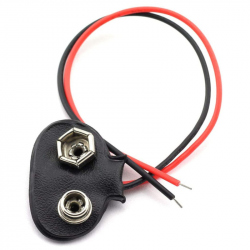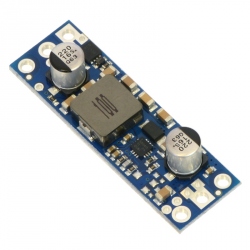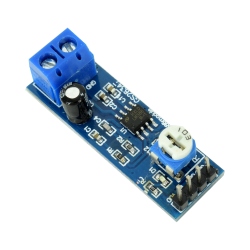Dupa plasarea solicitării de comandă, in sectiunea Istoric puteti vedea cate solicitări de comandă mai avem de procesat inaintea dumneavoastra
Program de lucru: Luni - Vineri 9:00 - 18:00, pauza 13:00 - 14:00.
Se efectueaza lucrari de mentenanta la site si pot aparea erori. In cazul in care intampinati erori va rugam sa reincercati mai tarziu.
Ridicarea personala este disponibila pentru comenzile achitate in avans. Se pot ridica dupa ce sunt pregatite.
Niciun produs
 Mărește
Mărește
Sursă Pololu Step-Up/Step-Down S9V11F5 de 5 V (Coborâtoare/Ridicătoare)
0104110000027757
Produs nou
Sursă Pololu step-up/step-down S9V11F5 utilă pentru a menține o tensiune de ieșire de 5V, indiferent daca tensiunea de intrare este mai mică sau mai mare de această valoare, la un curent maxim de ieșire de 1.5A.
Acest produs nu mai este in stoc
- Scrie o recenzie
- Elimina acest produs din lista mea de favorite.
- Adauga acest produs la lista mea de favorite.
- Imprimă
Informații
Caracteristici tehnice:
- Tensiune de intrare: 2V - 16V (3V necesari pentru pornire, apoi poate lucra până la 2V);
- Tensiune de ieșire: 5V;
- Acuratețe: +5/-3%;
- Curent de ieșire maxim tipic: 1.5A (acesta poate fi mai mic sau mai mare, în funcție de tensiunea de intrare);
- Curent maxim de scurgere: 200uA;
- Protecție la supratemperatură și scurtcircuit;
- Eficiență de până la 95%;
- Curent de start-up limitat la 700mA;
- NU există protecție la alimentare inversă.
Dimensiuni foarte mici: 7.6 × 11.4 × 3.8 mm.
Acest produs reprezintă o sursă de alimentare step-up/step-down ce poate menține o tensiune de ieșire constantă la 5V, indiferent daca tensiunea de intrare este mai mică sau mai mare de 5V. Curentul normal de ieșire este de 1.5A daca tensiunea de intrare este apropiată de 5V, și mai mic sau mai mare daca tensiunea de intrare este mai mică, respectiv mai mare de 5V.
Dimensiunile acestei surse sunt foarte mici, ceea ce o recomandă pentru o gamă variată de proiecte, putând fi inclusă cu ușurință în spații foarte mici. Eficiența este foarte bună, aflându-se în mod normal între 85% și 95%.
Pentru mai multe detalii, consultați pagina producătorului.
Recenzii
Clienții care au cumpărat acest produs au mai cumpărat:
-

Capac...
Capac Colorat pentru PotențiometruNegru cu Roșu
$0.24
-

Suport...
Acest produs este folosit pentru a conecta o...
$0.31
-

Sursă Pololu...
Sursă Pololu Step-Up U3V50F12 de 12 V,...
$32.64
-

Mini...
Mini Breadboard colorat, ideal pentru...
$0.57
-

Modul DC-DC...
Modul DC-DC Step Down LM2596S
$3.12
-

Mini...
Mini Breadboard colorat, ideal pentru...
$0.57
-

Amplificator...
Amplificator audio cu câștig mare bazat pe...
$1.56
-

Set 5 Clești...
Set 5 Clești în Miniatură
$9.60
-

Header de...
Header de Pini Mama 40p 2.54 mm
$0.36
-

Cutie din...
Cutie din Plastic cu 8 Compartimente și...
$1.92










